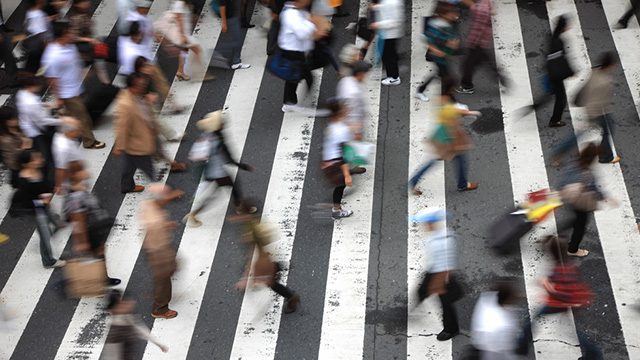SUMMARY
This is AI generated summarization, which may have errors. For context, always refer to the full article.

They cross roads, streets, and highways wherever and whenever they please, they ignore traffic signals and enforcers alike, and they stand almost in the middle of the road while waiting for public transportation.
They are a major contributor to congestion, and huge numbers of them are killed or injured on Metro Manila roadways every year.
Pedestrians are a serious problem in the metro, one that traffic managers have struggled with for decades.
But are they really as unmanageable as we like to think, or are we just not managing them the right way? Let’s take a fresh look at the situation. Maybe by understanding why pedestrians behave the way they do, we might be able to better control them.
A different kind of traffic…but still traffic
Pedestrians are the only element of traffic that naturally operate across, rather than with, the vehicular flow. As such, they have the potential to disrupt traffic significantly, by crossing at non-designated places or through moving traffic, and by standing in the roadway while waiting for public transportation. (READ: The trouble with taxis)
Although they have a great impact on the overall traffic system, pedestrians are largely ignored by that system. Enforcers rarely stop traffic to allow waiting pedestrians to cross safely, and it is not unusual to see enforcers allowing traffic to start moving while pedestrians are still in the intersection.
Although traffic agencies routinely conduct “anti-jaywalking” operations, regularly assigned enforcers almost never stop pedestrian violators. In fact, most enforcers seem to consider pedestrians a non-traffic element, no different from dogs or cats crossing the roadway.
In addition to being essentially invisible to traffic enforcers, pedestrians are also ignored by drivers. Crossing in a marked cross-walk is no safer for a pedestrian than jaywalking.
Whether on a major roadway or in a suburban neighborhood, drivers simply do not yield to pedestrians. In fact, it is common to see pedestrians, who are already inside a marked cross-walk, being forced to stop in the middle of the street to avoid getting hit by passing vehicles.
Traffic lights: More harm than good?
At intersections controlled by traffic lights, vehicles typically stop right on the cross-walk, forcing pedestrians to zig-zag through the line of vehicles to the other side. The white “stop-line”, which marks the point before the cross-walk where the first vehicle is supposed to stop, is completely ignored by both drivers and enforcers. I suspect that the average driver, and the average traffic enforcer, have no idea what that line is actually for.

Once the red light changes to green, the stopped vehicles start moving immediately, their drivers completely ignoring the pedestrians who must scurry quickly out of the road.
At intersections equipped with pedestrian-crossing lights, the design itself is usually faulty. When a pedestrian light turns green, indicating that it is safe to cross, the flow of straightaway traffic is made to stop, but vehicles turning from the intersecting road continue to turn, right through the crossing pedestrians.
At some intersections, a green arrow indicates when turning is allowed, but there is no red arrow to show when it is not. In practical terms, although it looks like a working system on the surface, there is really no safe-passage window for pedestrians at these intersections.
And because designated cross-walks don’t offer any more safety than jaywalking, pedestrians see no good reason to walk all the way to an intersection to cross.
Not denying the fact that pedestrians are just plain undisciplined with regard to traffic, this lack of protection must be recognized as part of the reason for their non-compliance. It’s a case of “What’s the point of following the rules?” Pleas from authorities for discipline, and even the inherent risks associated with crossing at non-designated points, will not change the behavior of pedestrians who feel they have no safer alternative.
So how do we fix this?
To encourage pedestrians to cross only at designated crossing points, we have to make sure they can do so safely and conveniently. This means we have to treat them as part of the overall traffic scheme. Enforcers have to see them, and manage them in the same way they manage the other moving parts of traffic.
At intersections, this means stopping traffic regularly, including turning traffic, to allow pedestrians to cross safely. It also means stopping vehicles behind the white stop-line, to keep cross-walks clear for pedestrians. At some intersections, it might be advisable to stop traffic on all sides at the same time, and allow all pedestrians to cross simultaneously. X-pattern cross-walks would help.
We also need to develop a “right-of-way” culture among drivers, with the appropriate traffic laws. In many countries, when a pedestrian is in any part of a marked cross-walk, no vehicle may pass until after the pedestrian is completely across. Philippine law doesn’t require this right now, but it should. In the Philippines, the burden is on the pedestrian to avoid getting hit by a car. It should be the other way around.
Although this explains pedestrian behavior, it doesn’t excuse it. Once we start providing pedestrians with safe alternatives to jaywalking, enforcers should act even more strictly against violators. Punishment is difficult, and truthfully not very effective. Fines and “on-the-spot seminars” don’t seem to be motivating any change in behavior.
But a pedestrian crossing improperly must still be dealt with. Aggressive, zero-tolerance enforcement may always be necessary. Calling a jaywalker back to his starting point, and directing him to the nearest designated crossing point, will eventually change behavior, especially once he realizes that cross-walks really are safer and just as convenient.
In the end, like much of Metro Manila’s traffic problem, the solution is simple. The solution is management. – Rappler.com
Michael Brown is a retired member of the US Air Force, and has lived over 16 years in the Philippines. He writes on English, traffic management, and law enforcement issues.
Pedestrian crossing image via ShutterStock.
Add a comment
How does this make you feel?
There are no comments yet. Add your comment to start the conversation.